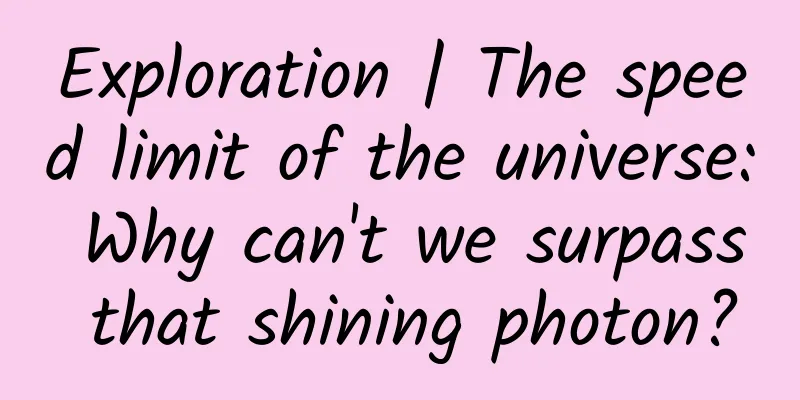Exploration | The speed limit of the universe: Why can't we surpass that shining photon?

|
On the vast stage of the universe, particles shuttle back and forth like dancers, each performing different rhythms and melodies. However, among these many dancers, two special dancers, photons and gluons, are particularly eye-catching. They lightly cross the trajectory of time and space at the fastest speed in the universe - the speed of light. The mystery behind this is intriguing. Photons, this unique dancer, enjoy the honor of having no rest mass. This is like when they are performing a dance, they do not need to bear additional resistance and can accelerate more easily. Moreover, the inertia of photons is very small, and they can reach the speed of light almost instantly. Once they arrive, they seem to be "locked" at this speed, and can neither accelerate nor decelerate further. In contrast, other particles, due to the limitation of rest mass, always find it difficult to reach the unreachable gate of light speed. They can only hover on the edge of the speed of light, but can never really cross that threshold. Although the gluon dancer has a slower pace, it has great strength and viscosity, and plays an important role in maintaining the structure of the universe. When they dance, they seem to be weaving a huge net, tightly connecting the matter in the universe. The characteristics and limitations of these two dancers have given people a deeper understanding of the mysteries of the universe. Gluon Gluons, this unique particle, also travels at the speed of light in the universe, and its properties are quite similar to those of photons, and are not bound by the laws of conventional physics. However, other particles such as electrons and protons that we are familiar with cannot fly freely at the speed of light like photons because of the rest mass they carry. Quantum chromodynamics is a theory that describes the interactions between quarks in matter. Quarks are the fundamental particles that make up protons and neutrons inside the nucleus, while gluons are the mediator particles that transmit the strong interaction between quarks. Just like photons transmit energy in electromagnetic interactions, gluons transmit force between quarks, allowing particles inside the nucleus to be tightly bound together. An important property of gluons is that they have color charge. Color charge is a property similar to electric charge, but unlike electric charge, color charge has three different states, usually called red, green, and blue. This three-color structure allows gluons to transmit complex interactions between quarks, thereby maintaining the stability of the atomic nucleus. It is worth mentioning that although gluons themselves have color charge, the interactions between gluons prevent them from forming color-neutral particles like protons or neutrons, which is also a significant difference between gluons and other fundamental particles such as photons. From the smallest atomic nucleus to the largest galaxy, gluons are silently playing a role. By studying the behavior of gluons, we can gain a deeper understanding of the microscopic structure and macroscopic evolution of the universe. For example, in high-energy physics experiments, scientists verify the predictions of quantum chromodynamics by observing the interaction between gluons and other particles, and then explore the basic laws of matter and the mysteries of the universe. In addition, gluons also play a potential application value in modern technology. Although we have not yet directly used gluons for technological innovation, with the in-depth study of the properties of gluons, new materials, new devices or new technologies based on the properties of gluons may appear in the future. For example, by using the properties of gluons to transmit strong interaction forces, it may be possible to develop new materials with higher stability and strength; or by regulating the behavior of gluons, more sophisticated microscopic manipulation and energy conversion can be achieved. ▏The bond of quality and the longing for the speed of light What prevents other particles from pursuing the dream of the speed of light? The answer lies in the seemingly ordinary mass. Mass plays an important role in physics, and it profoundly affects the trajectory of particles. According to Newton's second law, the acceleration of an object is proportional to the force it receives and inversely proportional to its own mass. This means that a particle with a larger mass needs a greater thrust to achieve the same acceleration. To make a particle with mass reach the speed of light, the force required would be infinite, which is almost impossible to achieve in reality. Therefore, mass becomes the threshold that limits the speed of particles. In contrast, photons have very little inertia because they have no rest mass, which is the secret of their ability to reach the speed of light effortlessly. Other particles are trapped by the dual shackles of mass and inertia and can only wander in the speed range below the speed of light. Let's look at another key factor - inertia. Inertia is the property of an object to maintain its original state, and its magnitude is proportional to its mass. Therefore, the larger the mass of a particle, the greater its inertia, and it becomes extremely difficult to change its speed. Especially from a static state to a level close to the speed of light, this is undoubtedly a huge challenge. However, photons are different. Since they have no rest mass, they have very little inertia. This is why photons can travel so easily above the speed of light. In contrast, other particles, constrained by mass and inertia, can only linger in the realm below the speed of light. ▏The mysterious dance of photons The Higgs field, the mysterious force of particle physics, is the key to giving elementary particles their mass. When elementary particles interact with it, they acquire their own unique mass. The strength of this interaction is directly proportional to the mass of the particle: the more intensely a particle interacts with the Higgs field, the more mass it acquires. However, photons are unique in that their interactions with the Higgs field are often minimal. In the "gentle embrace" of the Higgs field, other particles gain mass, but photons remain light and free, as if they have escaped the shackles of mass. This unique property enables photons to fly at the speed of light, and its role in the universe is crucial. As one of the most basic interactions, the particularity of photons ensures that the speed of electromagnetic force propagation - the speed of light, becomes the fastest speed in human cognition. Although photons can hardly acquire any trace of mass in their interaction with the Higgs field, photons are unique in the universe with their special properties. This property of photons is also the guarantee of the propagation speed of electromagnetic force, and it also reveals a mysterious way of interaction of elementary particles. All of this makes the Higgs field and photons an indispensable part of particle physics. ▏The wave-particle mystery of photons Photons, one of the most mysterious particles in nature, exhibit the mystery of wave-particle duality. They propagate in space in the form of waves, and can also interact with other particles like particles. The wavelength and frequency of a photon determine its color and energy, and it is well known that the energy unit of a photon moves at the speed of light. The motion state of a photon is closely linked to its mass. Einstein's theory of relativity states that the energy and mass of a photon are one. Considering that the speed of a photon is constant at the speed of light, the magnitude of its energy is actually closely related to the wavelength or frequency of the light. In other words, high-frequency photons have strong energy and correspondingly significant mass. Conversely, low-frequency photons have relatively small energy and weak mass. This characteristic is significantly different from the traditional view that the rest mass is zero, because a resting photon also has inherent energy and thus mass. So, how should we understand the mass of a photon at rest? According to the principles of relativity, a photon cannot actually reach a true resting state, because a resting photon means losing all its energy. However, in nature, a particle that completely loses energy does not exist. Therefore, we define the rest mass of a photon as zero. This property makes a photon show its mass characteristics only when it is moving. It is worth noting that this mass is directly related to its energy of motion. The wave-particle duality and mass of photons occupy a unique position in physics. Sometimes they appear in the form of waves, and sometimes they appear in the form of particles. The form and mass of photons depend entirely on their state of motion. A deeper understanding of the wave-particle duality and mass of photons has profound and significant implications for our understanding of the workings of the universe. Remember, this characteristic is not accidental, but a direct reflection of the nature of photons. Let's explore this topic further. The wave-particle duality of photons not only reveals strange things about nature, but also makes us think about the complex relationship between matter and energy. The energy of a photon is closely related to its frequency, which in turn is related to the degree of particleization of the light. In other words, the more particleized the light is, the greater its energy and the more significant its mass. Conversely, light with a low degree of particleization is more like a wave, with relatively low energy and weak mass. This characteristic is ubiquitous in our universe, and it allows us to better understand the workings of photons and the entire universe. ▏The mystery between the energy and mass of photons To explore the mystery of photons, we can't help but mention the important formula - E=mc², which is the principle of mass-energy equivalence proposed by Einstein. In the field of photons, the importance of this formula is self-evident, as it reveals the mysterious and strange correspondence between mass and energy. The energy and mass of a photon are closely related. Specifically, the energy of a photon can be obtained by multiplying its frequency by Planck's constant, while the mass of a photon is the result of its energy divided by the square of the speed of light. This reveals an interesting fact: the higher the energy of a photon, the greater its mass. When the speed of a photon approaches the speed of light, its energy will reach its peak, and its mass will be fixed at a certain value. The unique mass-energy relationship of photons reveals the mystery of how photons can exhibit dynamic mass even though they seem to lack rest mass. Therefore, the energy of photons largely determines their motion characteristics and mass properties. Under different circumstances, photons can exhibit different mass and energy characteristics, which profoundly affect their interaction with matter. This property of photons plays an important role in both the vast field of astronomy and the microscopic field of quantum physics. By deeply understanding the subtle relationship between photon energy and mass, we can more fully reveal the laws of photon motion and their role in the universe. This principle of mass-energy equivalence, E=mc², is the key to understanding the mutual transformation of matter and energy in the universe. It applies not only to the macroscopic world, but also to the microscopic world, and plays a unique role in the field of photons. It is this universality and uniqueness that makes photons an indispensable part of physics research. Therefore, let us continue to dig deeper into the mystery of this formula in order to reveal more secrets about the laws of photon motion and the mysteries of the universe. ▏ Interstellar travel of photons The uniqueness of photons is not only reflected in their unparalleled speed and mass, but also in the way they interact with other particles. In the vast stage of the universe, photons seem to have a detached attitude, and they hardly intersect with other particles, even the mysterious Higgs particle. Higgs particles, like tiny ripples in the Higgs field, give other particles mass. Elementary particles, such as electrons and quarks, acquire most of their mass in subtle interactions with Higgs particles. However, the communication between photons and Higgs particles is extremely weak and almost imperceptible. This subtle communication allows photons to travel easily through the universe without being bound by mass. This immune property of photons is the key to their ability to travel at a constant speed, the speed of light. Unlike other particles that slow down and gain mass when interacting with the Higgs particle, photons always maintain their constant speed without any hindrance. This also provides important clues for us to understand the origin of particle mass. The existence of the Higgs particle makes people realize that the source of mass is closely related to the operation of the universe. The subtle relationship between photons and Higgs particles is also a microcosm of the complex interaction between various particles in the universe. It is this interaction that shapes the world we perceive and determines the behavior and characteristics of various particles. Therefore, understanding the characteristics of photons not only helps us understand the nature of the universe, but also provides us with new perspectives and ideas for exploring unknown areas. With the continuous progress of science, we have reason to believe that one day in the future, humans will be able to unveil these mysteries and gain a deeper understanding of how nature works. In this process, the phenomenon of photons and gluons flying at the speed of light will continue to serve as an important clue to guide us in exploring the mysteries of the universe. (Picture from the Internet) Author | Kiwi graduated from Lincoln University in New Zealand. He has a strong interest in popular science knowledge and has published popular science articles in many popular science journals. He pays attention to facts and actively explores cutting-edge technology. |
<<: How bright is China’s bright business card—high-speed rail?
>>: Who created the largest cycle on Earth? It's right next to you!
Recommend
Instant messaging apps are growing faster than social networking sites
Instant messaging apps and social networks, which...
How to effectively collect user feedback in mobile apps
This article analyzes various mainstream feedback...
The Ministry of Industry and Information Technology talks about the removal of Didi Chuxing APP: All departments form a joint force to strengthen App governance
[[411758]] This morning, at a press conference he...
Are shared bikes doomed to fail?
The closure of shared bikes has not slowed down pe...
Tie a "green ribbon" to the "Sea of Death"
In the heart of the Taklimakan Desert, known as t...
How to operate social e-commerce well?
We always say that when the wind blows, even pigs...
The heart-wrenching experience of the TV version of "Never Give Up"
Screen: Sound Effects: operate: Plot: Experience:...
Finally decided, Apple completely gave up on under-screen fingerprint recognition, iOS15.4 made great contributions
Double unlock? Is Face ID the future, or is Touch...
Want to experience Google's latest Fuchsia OS on your computer? Try FImage
Earlier this week, Google released Fuchsia OS, bu...
A complete analysis of the six major Internet profit models!
In the Internet age, traffic is money. With traff...
How much does it cost to develop the Honghe pregnancy and childbirth mini program? What is the quote for developing the Honghe pregnancy and childbirth mini program?
According to industry insiders, mini programs wil...
I heard that sequels dominated the Spring Festival period! Why do movies love to have sequels?
Looking back at the movies during the Spring Fest...
Dingdong TOP smart speaker experience: This little guy can make all the devices in the home have their own Siri
Who says smart speakers have to stand on a table ...
6 ways to sell products through live streaming on Xiaohongshu!
Since 2019, Xiaohongshu has officially launched t...









